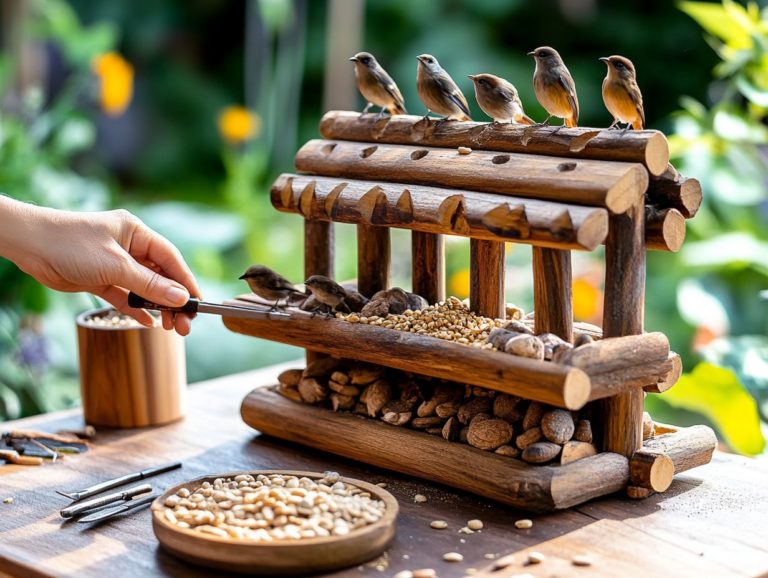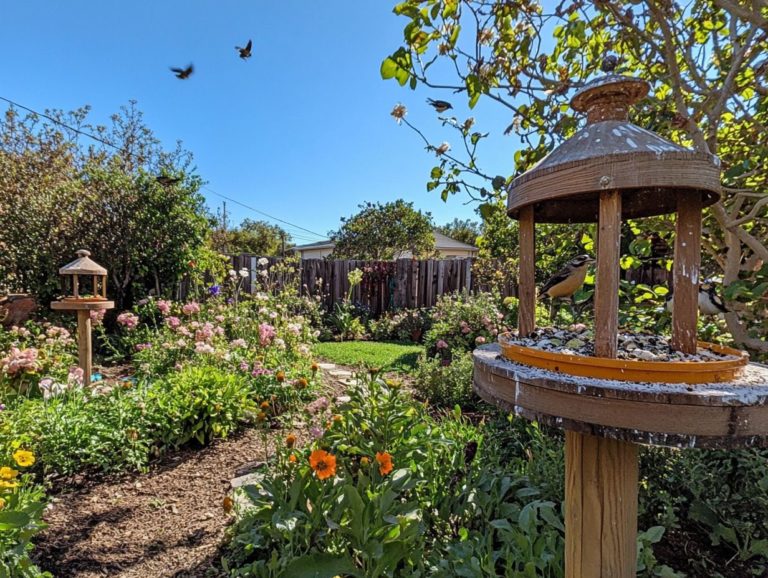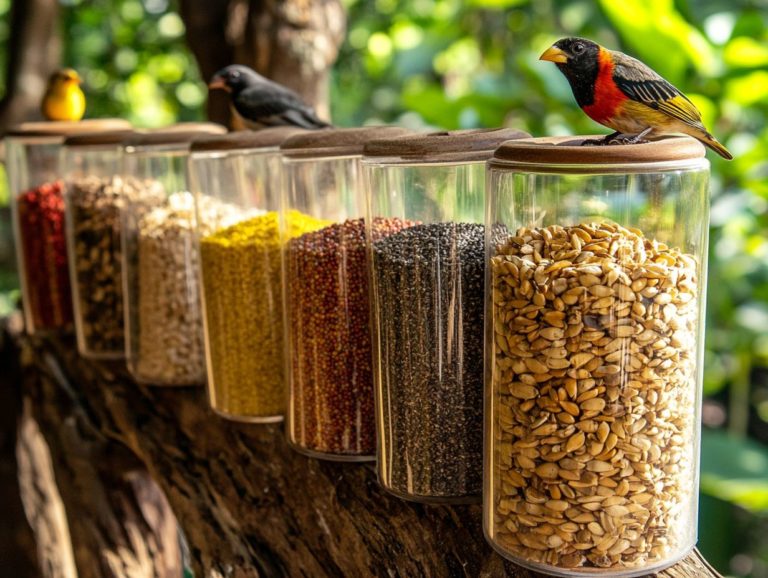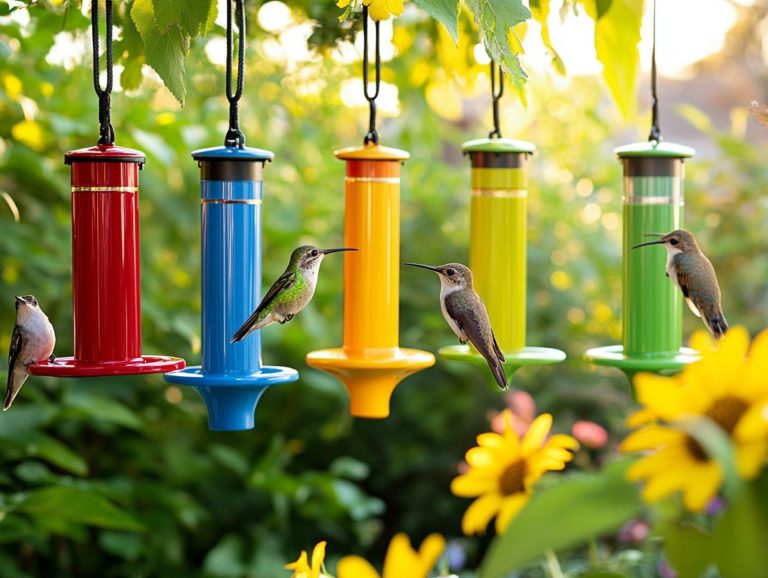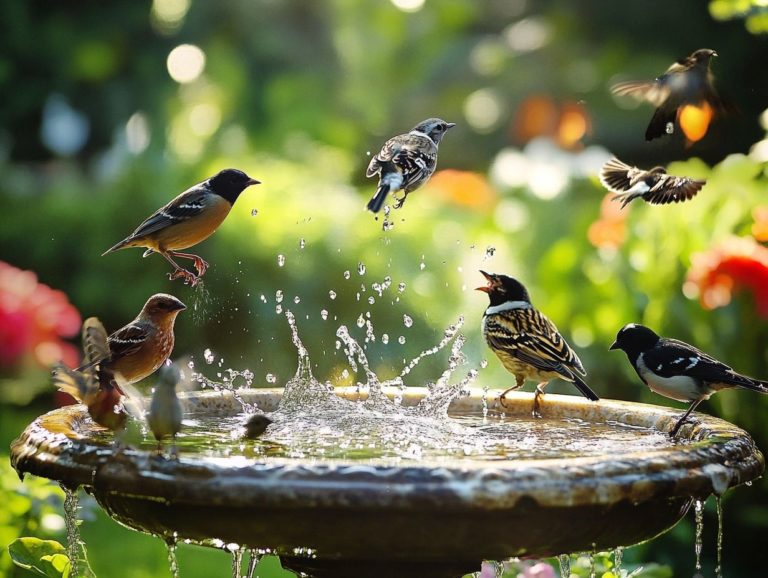The Best Bird Feeders for Large Areas
If you re aiming to attract a colorful variety of feathered friends to your backyard, selecting the right bird feeder is key.
With options ranging from platform feeders, which provide a birdwatcher’s opportunity to observe the diverse interactions among different bird species, to specialized choices like hummingbird and suet feeders, there s an ideal selection for every type of bird and garden layout.
This guide will walk you through the different types of feeders, provide tips for choosing the right size, and offer essential maintenance advice.
By the end, you ll be well-prepared to create a welcoming space for birds, all while relishing the beauty they bring to your outdoor area.
Contents
- Key Takeaways:
- 1. Platform Feeders
- 2. Hopper Feeders
- 3. Tube Feeders
- 4. Suet Feeders
- 5. Ground Feeders
- 6. Window Feeders
- 7. Nyjer/Thistle Feeders
- 8. Hummingbird Feeders
- 9. Oriole Feeders
- 10. Mealworm Feeders
- 11. Selecting the Right Size for Your Large Area
- 12. Factors to Consider When Choosing a Bird Feeder
- 13. Maintenance and Cleaning Tips for Large Bird Feeders
- 14. Common Problems with Large Bird Feeders and How to Solve Them
- 15. Enhance Your Bird Feeding Experience with Accessories
- Frequently Asked Questions
- What makes a bird feeder suitable for large areas?
- What types of bird feeders are best for large areas?
- Can I use multiple bird feeders in a large area?
- What features should I look for in a bird feeder for large areas?
- Do I need to place my bird feeder in a specific location in a large area?
- Can I make my own DIY bird feeder for a large area?
Key Takeaways:
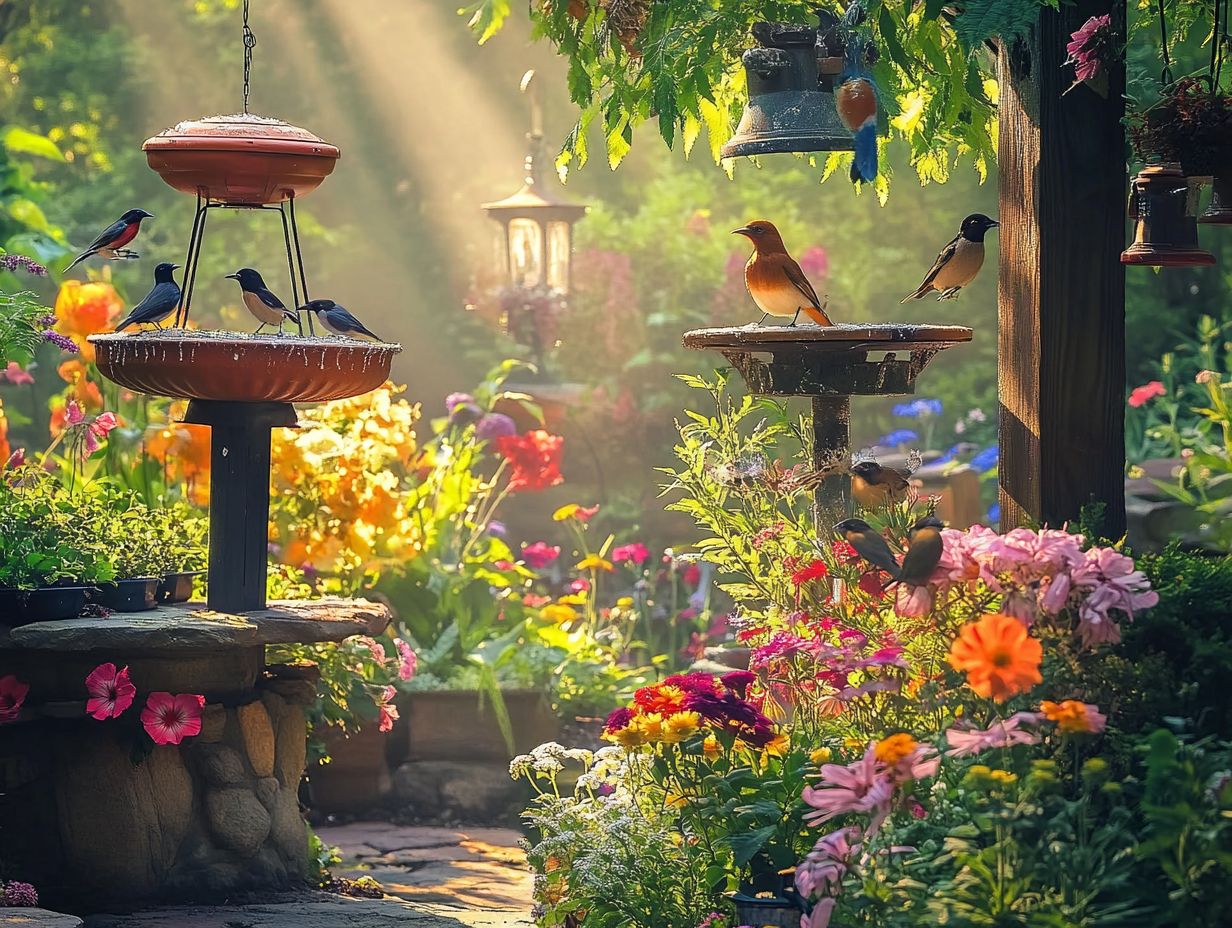
- Choose platform, hopper, or tube feeders for large areas – they hold more food and attract a variety of birds.
- Suet feeders are great for attracting woodpeckers and other insect-eating birds to your large backyard.
- Regular maintenance and cleaning of large bird feeders is important to ensure the health of your lovely birds.
1. Platform Feeders
Platform feeders are an outstanding choice for you as a bird enthusiast, offering a spacious, open flat tray that draws in a wide range of birds. They re perfect if you re looking to elevate your backyard birdwatching experience.
These feeders can accommodate everything from ground-feeding birds to larger types of birds, creating an optimal feeding environment that encourages diverse bird activity.
Their thoughtful design often features raised edges to prevent seed spillage, while also providing ample space for multiple birds to feed at once, effectively reducing competition. According to the Cornell Lab of Ornithology, platform feeders are particularly adept at attracting species like cardinals, jays, and doves, all of which prefer an unobstructed area for foraging.
You ll be thrilled to watch different birds interact, as these feeders offer a front-row seat to their delightful behaviors. By incorporating a mix of seeds, grains, and even fruit, platform feeders cater to the unique preferences of various birds, enriching your watching experience even further.
2. Hopper Feeders
Hopper feeders stand out as a favored choice for bird enthusiasts, expertly dispensing seed while shielding it from the elements, making them a dependable option for year-round bird feeding.
These feeders have an enclosed compartment that holds a generous amount of seed, meaning you won’t need to refill as often. Many also feature clever mechanisms that effectively deter squirrels, ensuring that the seed remains a delightful treat for its intended avian guests.
As a bird lover, you’ll appreciate the variety of seed types available, from sunflower seeds to mixed blends, each attracting a different array of feathered visitors, from cheerful chickadees to vibrant finches. By understanding these design features, you can create a diverse and inviting sanctuary in your backyard, significantly enhancing your birdwatching experience.
3. Tube Feeders
Tube feeders are perfect for small seed types. They attract finches and other small birds while being easy to use and clean.
These feeders have a vertical tube with multiple feeding ports. This allows birds to perch comfortably and access seeds while reducing waste.
For the best results, use nyjer or sunflower seeds. Tube feeders work well in all weather; their covered design keeps seeds dry from rain and snow.
4. Suet Feeders
Suet feeders offer a crucial source of animal protein for birds, particularly during the colder months when their energy demands spike. Adding these feeders to your garden attracts a diverse array of bird species eager to refuel.
You’ll find various types of suet feeders available, including wire mesh models, cages, and specialized platforms tailored to different feeding preferences. These feeders entice woodpeckers and nuthatches, along with ground-feeding birds, turning your outdoor space into a vibrant gathering spot.
To maximize bird visitation, consider placing suet feeders in strategic locations, like near trees or sheltered areas. The nutritional benefits of suet are essential for birds seeking sustenance during migration and winter, ensuring that your garden becomes a lively hub of activity for feathered friends.
5. Ground Feeders
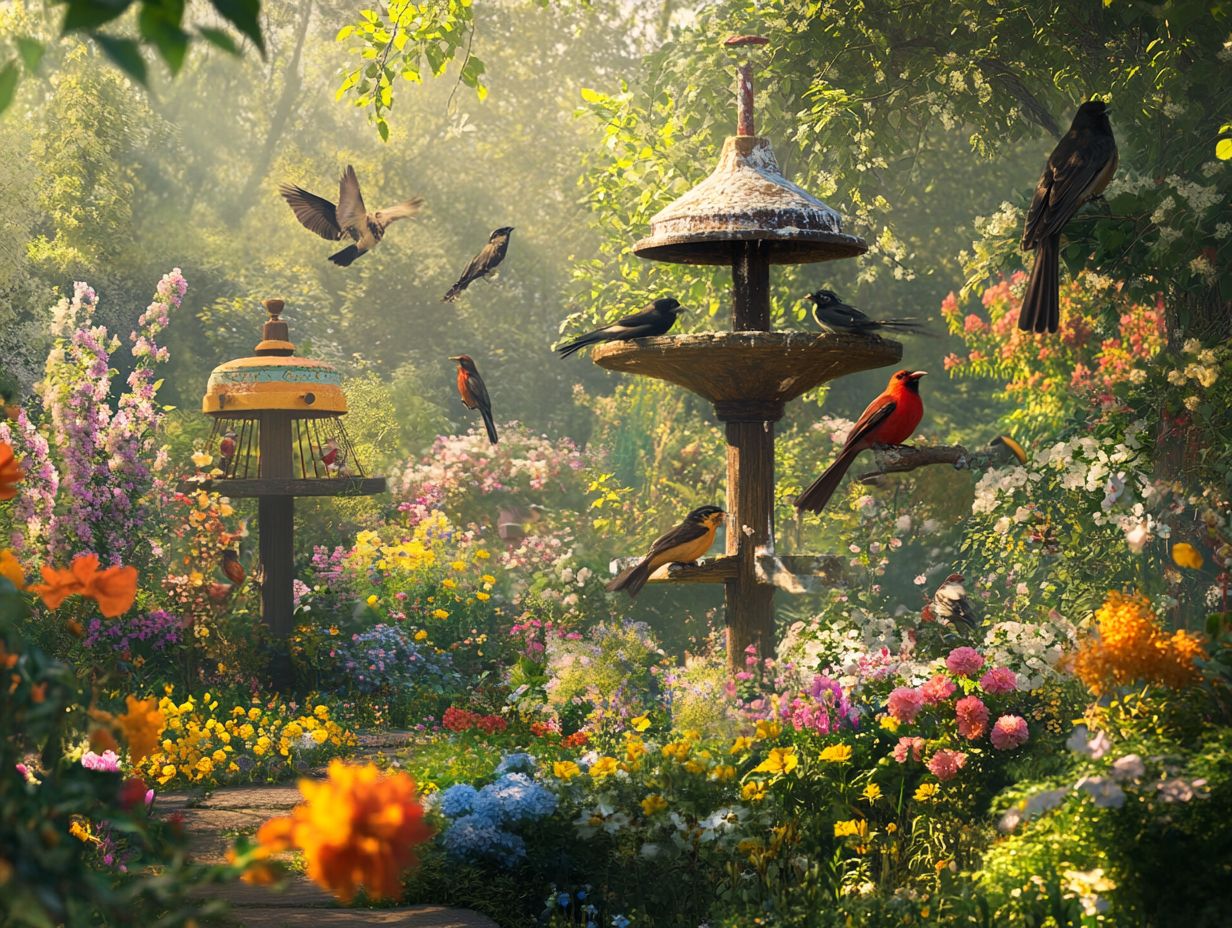
Ground feeders create a bird-friendly haven by offering direct access to seeds and food right on the ground, drawing in a delightful array of ground-feeding birds like sparrows and doves.
These feeders don t just stop there; they also attract other species such as juncos and quail, contributing to a vibrant wildlife ecosystem in your backyard. To cultivate an inviting feeding environment, consider scattering a mix of seeds like millet, sunflower hearts, and cracked corn, which will appeal to a diverse range of birds.
Positioning feeders in sheltered spots with nearby foliage will provide birds with a sense of security. Regular maintenance is essential; clearing away leftover seeds not only prevents mold growth but also keeps unwanted pests at bay.
6. Window Feeders
Window feeders provide you with a unique opportunity to immerse yourself in the world of birdwatching, allowing you to observe a delightful array of birds from the comfort of your own home while ensuring easy maintenance and cleaning.
These feeders come in various types, such as tray feeders, tube feeders, and suction cup feeders, each designed to cater to different bird species and their feeding preferences. By placing a window feeder in a strategic spot perhaps a sunny window or near lush vegetation you can effectively attract a diverse range of feathered visitors.
To create a healthy environment for these birds, it s essential to clean the feeders regularly and replace any old seed. Dirty feeders can become breeding grounds for bacteria and mold, which is far from ideal. Keeping the surrounding area free from debris will not only help prevent disease but also encourage more frequent visits from your avian guests.
7. Nyjer/Thistle Feeders
Nyjer or thistle feeders attract finches and small birds with their favorite Nyjer seeds. They come in various designs, often featuring small feeding ports to ensure only tiny birds can access the seeds.
When choosing a Nyjer feeder, consider the bird species in your area and the feeder s material and construction. Metal feeders are strong and squirrel-resistant, while plastic ones are lighter but less durable in bad weather.
Selecting fresh Nyjer seeds is also crucial for enticing these delightful songbirds. A well-designed feeder ensures smaller birds can easily access the seeds and reduces seed waste and spoilage.
8. Hummingbird Feeders
Hummingbird feeders help attract these beautiful birds. They provide a mix of sugar and water essential for their survival.
You can find various styles, including saucer, tube, and window-mounted options. Each is designed for different environments and personal preferences.
For the best results, place your feeders in shaded areas, away from direct sunlight. This keeps the sugar-water fresh and the birds cool.
Maintain a proper sugar-water ratio of one part sugar to four parts water. Clean the feeders every few days to prevent mold buildup.
9. Oriole Feeders
Oriole feeders attract vibrant birds with a mix of fruit and grape jelly. They add charm to your backyard feeding station.
To entice these colorful visitors, understand their dietary preferences, which include fresh oranges, nectar, and sugar water. Place the feeder in a shaded area near flower gardens or trees.
Regular maintenance is essential. Refresh the food every few days to encourage visits and prevent spoilage.
Position the feeder away from heavy foot traffic to make orioles feel secure and comfortable as they dine.
10. Mealworm Feeders
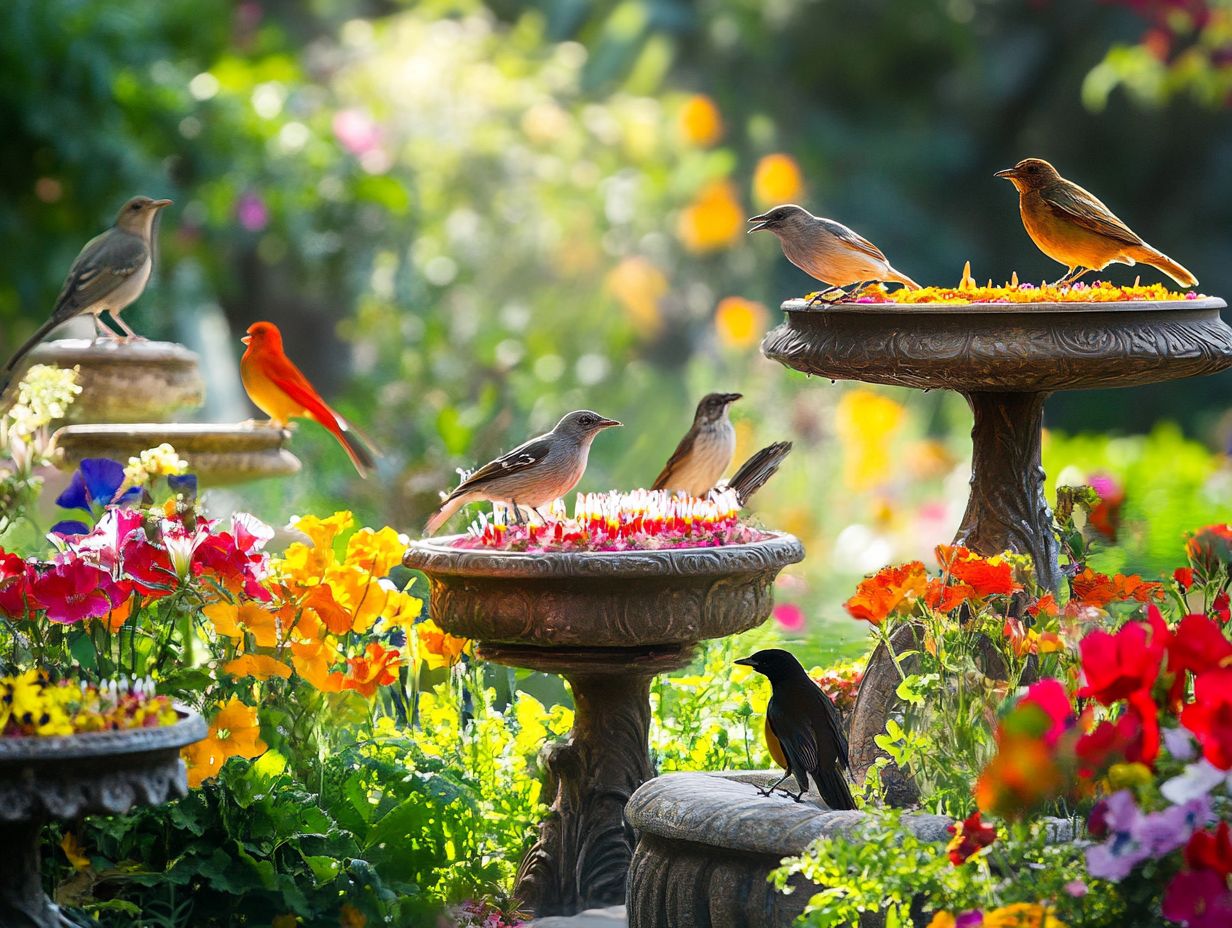
Mealworm feeders provide a vital source of protein for insect-eating birds. They attract larger birds and ground feeders that thrive on this nutritious offering.
These feeders are especially valuable during the breeding season. Birds like blue jays, robins, and chickadees flock to these enticing spots.
Place the feeder near trees or shrubs for safety from predators. Regularly clean it to prevent mold and refill it with fresh mealworms.
Shade will help keep the mealworms from drying out, creating a welcoming haven for your feathered friends.
11. Selecting the Right Size for Your Large Area
Choosing the right size and type of bird feeders is crucial. It will enhance your birdwatching experience while attracting various bird species to your backyard, like hummingbirds and pigeons.
This choice depends on some key factors, such as the local bird species, seasonal changes, and your garden’s landscape. For instance, larger feeders, like hopper feeders (which have a storage bin), can hold more birds, especially in open areas.
Try different feeder styles, like tube feeders (which are long and cylindrical), platform feeders (flat surfaces), or suet feeders (holding suet cakes) to cater to various bird preferences. Proper assembly ensures your feeders are sturdy and safe, encouraging frequent visits.
Placement is key. Situate feeders near sheltered spots away from predators to optimize feeding activity and create a lively atmosphere for your avian visitors.
12. Factors to Consider When Choosing a Bird Feeder
When selecting a bird feeder, consider factors like feeder design, ease of use, and maintenance requirements. These elements greatly affect how well your feeder attracts birds.
The feeder’s design is key as it impacts the types of birds it attracts, such as starlings and blackbirds. A well-structured feeder mimics a bird’s natural feeding environment, making it more appealing.
Ease of cleaning is vital; feeders that can be quickly taken apart and washed help prevent mold and bacteria growth. This maintenance encourages you to keep your feeders in great shape, enhancing your birdwatching experience.
By considering these factors, you can create a vibrant space that attracts a delightful variety of birds!
13. Maintenance and Cleaning Tips for Large Bird Feeders
Regular maintenance and cleaning are essential for your large bird feeders. This not only helps prevent diseases but also ensures a safe feeding environment for birds. Enjoy a vibrant and healthy bird population while appreciating the diverse birds that visit.
To keep your feeders in top shape, clean them every two weeks during peak feeding seasons. A simple mixture of warm water and mild soap effectively eliminates harmful bacteria and mold, especially in humid weather. This is crucial for bird feeder maintenance.
Using feeders designed for easy disassembly makes the cleaning process a breeze. Regularly check seed levels, such as sunflower seeds and Nyjer seeds, and promptly discard any spoiled or moldy food to significantly enhance avian health.
By focusing on these straightforward yet impactful maintenance practices, you can make a big difference in promoting a thriving avian community right in your backyard. This encourages feeding birds year-round!
14. Common Problems with Large Bird Feeders and How to Solve Them
Large bird feeders can introduce challenges, including seed spillage and the unwelcome presence of critters, which can lead to problems with feeding birds and maintaining a clean area.
One persistent issue is the invasion of squirrels, who seem to have a sixth sense for locating the feeder and quickly devouring the seeds meant for the birds. Seed spillage not only creates a mess but also fosters the growth of weeds nearby, attracting even more unwanted pests.
To tackle these nuisances, consider investing in squirrel-proof feeders, which are designed to keep furry pests away from your bird food. For example, the Brome Squirrel Solution 200 has ingenious mechanisms to thwart these intruders. Regularly cleaning your feeder and using seed trays will help contain the mess and reduce waste, ensuring a delightful feeding experience for all your avian visitors.
Start your cleaning routine today and watch your backyard become a birdwatcher’s paradise!
15. Enhance Your Bird Feeding Experience with Accessories
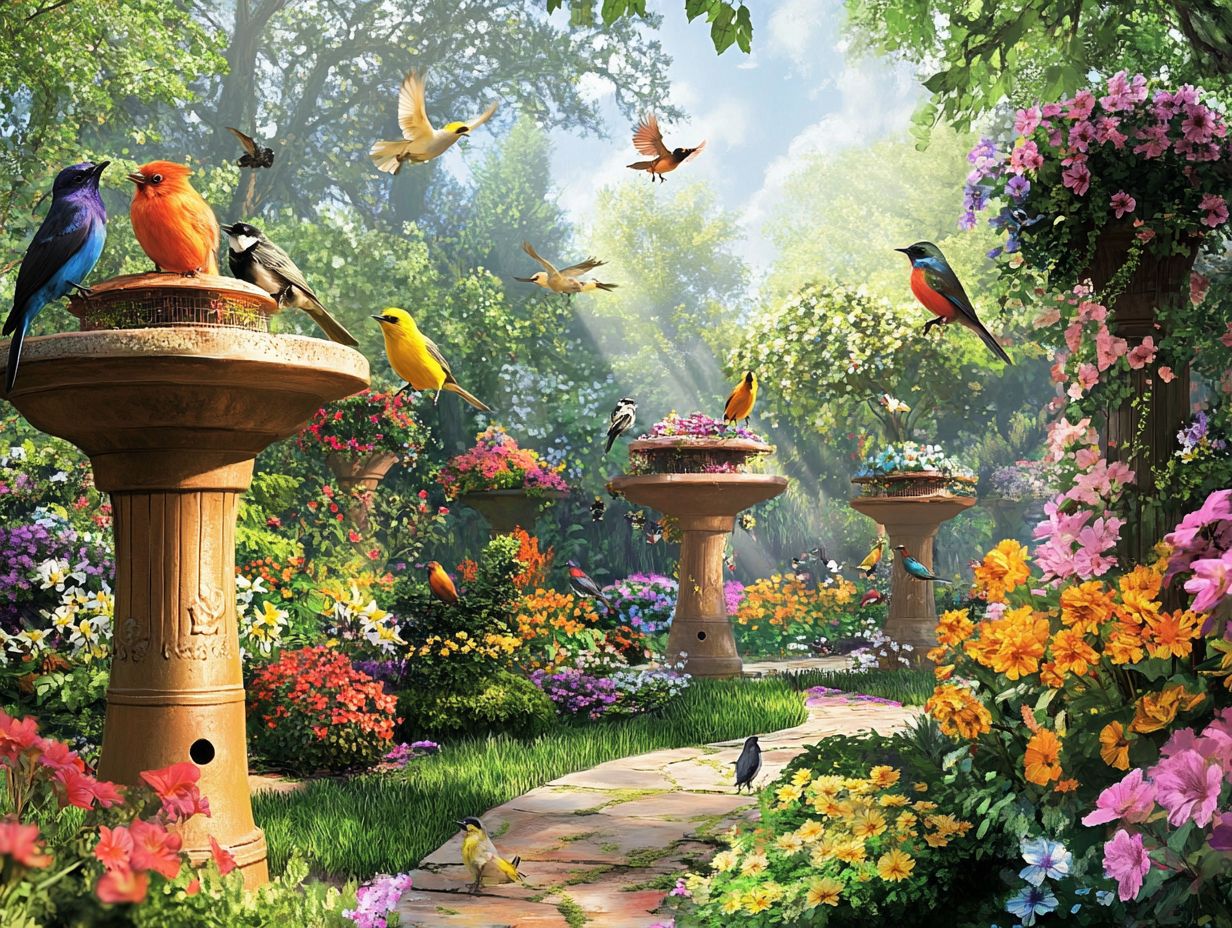
Enhancing your bird feeding experience is easy with the right accessories. These tools improve functionality and attract a wider variety of birds, including hummingbirds that enjoy nectar feeders.
Incorporating squirrel deterrents keeps pesky critters from stealing your birdseed. This ensures your feathered friends enjoy their meals without interruption.
Using special cleaning tools is essential for keeping your feeders hygienic. This protects the health of visiting birds.
Explore diverse feeding options like seed cakes and suet blocks. These accessories foster a vibrant avian community, transforming your outdoor space into a lively hub.
Frequently Asked Questions
What makes a bird feeder suitable for large areas?
A suitable bird feeder should have a large capacity for bird food. It must be sturdy enough to withstand harsh weather and attract a variety of birds like finches and blue jays.
What types of bird feeders are best for large areas?
Platform feeders, hopper feeders, and tube feeders are popular for large areas. They hold plenty of bird food and attract various birds, including cardinals and grackles. For those looking to enhance their bird-watching experience, exploring the best bird feeders for seasoned bird watchers can be beneficial.
Can I use multiple bird feeders in a large area?
Yes! Using multiple feeders allows you to offer different types of bird food, like Nyjer seeds (which finches love) and sunflower seeds. This attracts a wider range of bird species.
What features should I look for in a bird feeder for large areas?
When choosing a bird feeder for large areas, select one with a large capacity and durable, weather-resistant materials. If you’re interested in catering to smaller birds, consider the best bird feeders for small birds that feature adjustable settings to control food dispensed, and ensure it’s easy to refill and clean.
Do I need to place my bird feeder in a specific location in a large area?
Place your bird feeder in a safe, open spot to attract a variety of birds. Keep it away from predators and provide shelter from harsh weather. Make sure the location offers good water drainage to keep the food dry and prevent diseases.
Can I make my own DIY bird feeder for a large area?
Absolutely! You can create a DIY bird feeder using a large plastic container or simple materials for a platform feeder. Follow guidelines for construction and placement to ensure your feeder is effective and easy to use.

